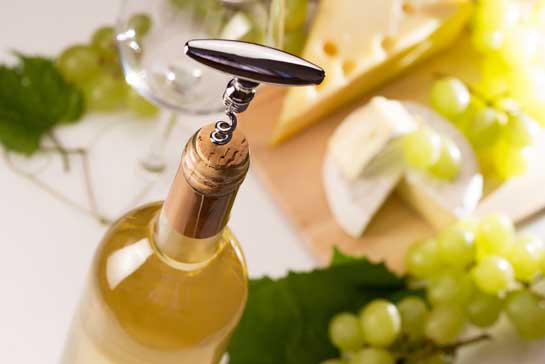
Serving the Host
In ancient times, the host was initially served wine to be sure it was acceptable and because, before there was a bottle or a cork, wine was preserved in amphorae (two-handled jugs) with wax or olive oil as sealers, and upon opening, wax or oil could get into the wine. As a courtesy, the host took the first glass to assure that guests did not get any impurities in their glasses.
Wine Corks
Corks as we now know them were developed in the early 1600s, at least in England. Shakespeare referenced corks in As You Like It. Prior to this, wine was often preserved in soaked olive oil rags, wax, or pitch. The earliest corks, as we know it, were probably glass stoppers made for a specific bottle. This became impossible as the wine bottling production grew; glass stoppers, moreover, often became stuck to the bottle prompting breakage, and were consequently relegated later to liquor decanters.
Wine Labels
We have no history of the first wine label; most of the older labels identifying a wine were hand written at the winery and can still be seen in many of the older French cellars. Prior to labels, corks identified the wine’s producer, who would mark or sign the cork, a process still with us today. Thus, when a wine was shown, the waiter would open the bottle at table and show the cork to the host insuring the accuracy of the wine ordered. Today, when presented with a cork, the host is supposed to sniff or examine the cork, which is largely an exercise in affectation.
Corkscrew and Wine Bottles
As the wine industry expanded, the invention of the corkscrew became necessary. Historians record the date of the corkscrew in the late 1600s or early 1700s, and it is considered an English invention. (Reverend Henshall was granted the first corkscrew patent in England in 1795). Glass stoppers became unnecessary and unwanted. Before corks and corkscrews, however, bottle manufacturing had to grow; as it did, the wine industry also grew, and it no longer had to ship wine arduously in bulk or in large barrels. Bottles made wine exports more expansive and shipping easier. As for wine in bottles, Master of Wines and wine author Jancis Robinson reports that the first bottled wine was Port in 1775, and laying down wine for aging became a greater reality.
The Punt
The punt — the hollow at the bottom of a Champagne bottle — has a various history. Why is it there? One view is that after a glassblowing procedure a jagged scar (called a pontil) was left and to get rid of it the blower would push up into the bottom of the bottle and create an indentation. Thus, the punt became a Champagne feature. Some say, the punt was also there to avoid scratches to table surfaces left by the scar. More important, the punt added stability to the bottle: tables were hand-planed, and Champagne bottles rested unevenly on the table: the punt made the bottle steady. Moreover, “the greater purpose of the punt,” as Karen MacNeil notes in her Wine Bible, is to prevent the bottle from bursting “and the punt allows for a more even distribution of pressure…preventing disastrous explosions that were a common and serious problem for early Champagne producers.”
Text by Richard L. Elia
